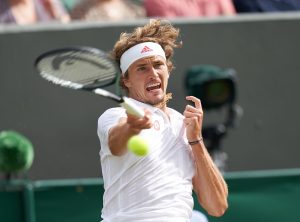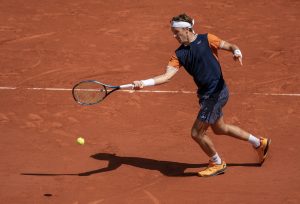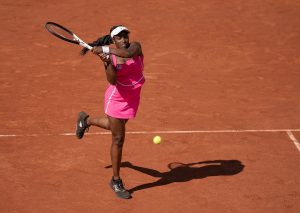Tennis, outside of the Grand Slam tournaments, once grew in popularity in large part due to exhibition tennis that was played for a profit by the world’s best tennis players before the “Open Era”. These exhibitions had a way of introducing more fans to the sport, and providing for innovation and change as well, in an era where other major tournaments like Wimbledon still clung hard to tradition. Even after the ATP and WTA tours got going and allowed a tennis players to earn a living playing the sport, exhibitions remained relevant, most notably the Battle of the Sexes matches, the 1980’s Challenge of Champions, and the Hopman Cup, which began in 1989.
These days however, despite tennis being more lucrative, and popular than ever, the tennis exhibition is in decline, fueled by gimmicks, and a focus on star power, rather than intense competition. 2007’s battle of the surfaces, played on a half grass, half clay court between the then top two players in the men’s game, Rafael Nadal and Roger Federer, was an interesting idea, and in fact an enjoyable match, but in many ways it started a profitable decline into gimmicky exhibitions featuring top players.
The off season in December is the primary time for modern exhibitions to take place, along with the time around the Grand Slam tournaments. The Hopman Cup, once a top event featuring ATP and WTA players competing for their countries, just announced that they were switching to the “Fast 4” tennis format, an idea originating from Tennis Australia to speed up and shorten matches, for the mixed doubles matches in Perth. This change is likely welcomed by TV broadcasters and corporate sponsors, who are excited to have shorter matches, but hardcore tennis fans are less than happy, as the Hopman cup just confirmed its irrelevance to start the season. Last year the Hopman Cup added a second Australian team, and players’ willingness to withdraw from the competition for the slightest reasons has weakened its field, which once featured top players who not only were there for the appearance fee, but also for top competition, just like Davis Cup and Fed Cup.
Another Australian exhibition, the Kooyong Classic in Melbourne, has managed to remain on the tennis calendar, but likewise has seen an increase in player withdrawals, and players entering the exhibition to just play one or two matches, rather than contest the title. The Masters Guinot-Mary Cohr, introduced in 2009, and the Boodles Challenge, introduced in 2002, have lasted in their spots before the French Open and Wimbledon respectively, but are more relevant to see players than to watch them compete at a high level, and barely register in terms of relevancy.
2012’s Gillette Federer Tour of South America, which featured large crowds, but limited competitive tennis, may have spawned the idea for the International Premier Tennis League, which was announced in 2013, and offered lucrative money for a host of top ATP and WTA players to participate at first. IPTL was a relative hit in 2014 and 2015 with fans and TV audiences, who were hungry for tennis in Asia, and any tennis at all during the offseason. IPTL was a flop in 2016 however, with fewer top players competing, and smaller crowds. Originally thought by some to be a competitor to the traditional ATP and WTA tours, the gimmick may not last much longer, and if it does, it may end up featuring players on par with World Team Tennis, another good idea at first that has slowly turned into a competition that features mostly ATP Challenger level competition.
The BNP Paribas Showdown in Madison Square Garden was supposed to bring top tennis to New York for the only other time besides the US Open, but likewise for such a highly publicized event, the actual quality of play is sorely lacking, unlike the other two BNP Paribas sponsored events, the Masters tournaments in California and Paris.
The last remaining “serious” exhibition is the Mubadala World Tennis Championship held in Dubai. The WTC likely remains relevant because it features a small field, and is short in terms of length, along with the prize money on offer. Still, with the increase prize money and seriousness of the ATP and WTA tours, most players simply don’t seem to want to risk injury or fatigue from playing exhibitions. Injuries from IPTL tennis set back the seasons of multiple players in the past couple of years, and as a result players seem to be adjusting away from playing exhibitions, or taking them seriously.
https://www.youtube.com/watch?v=G-tYxRoJle0
With tennis exhibitions in a sorry state, it appears the ATP and WTA tours have fended off challenges to their supremacy as the elite professional tennis competitions, and until organizers and sponsors move away from killing the relevance of exhibitions with shortened matches, substitutions, scoring changes, and gimmicks, it’s unlikely exhibitions are going to draw more than a casual audience at this point.
The decline of exhibition tennis may be for the best, but I’m not convinced, as the decline in relevance of all-star games in other major sports leagues and events such as the Senior Bowl has not helped other sports leagues grow, or expose new fans to the talent, excitement, and skill on offer. In the NBA all-star game for example, rather than a true battle between the best of the Eastern and Western conferences, the game has turned into a dunk and three point showcase with no defense. The NHL all star game has changed formats multiple times, and some sports like the Australian Rules Football League have seen their all-star games/exhibitions cancelled altogether.
Main Photo:






